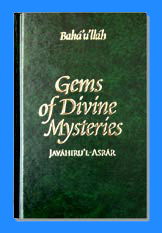Gems of Divine Mysteries
| |
|
Contents |
|
IntroductionThe decade-long exile of Bahá'u'lláh in 'Iráq began under the harshest of conditions and at the lowest ebb in the fortunes of the Bábí Faith. It witnessed, however, the gradual crystallization of those potent spiritual forces which were to culminate in the declaration of His world-embracing mission in 1863. In the course of these years, and from the city of Baghdád, there radiated, Shoghi Effendi writes, "wave after wave, a power, a radiance and a glory which insensibly reanimated a languishing Faith, sorely-stricken, sinking into obscurity, threatened with oblivion. From it were diffused, day and night, and with ever-increasing energy, the first emanations of a Revelation which, in its scope, its copiousness, its driving force and the volume and variety of its literature, was destined to excel that of the Báb Himself."[1] Among these early effusions of the Pen of Glory is a lengthy epistle known as Javáhiru'l-Asrár, meaning literally the "gems" or "essences" of mysteries. A number of themes it enunciates are also elaborated in Persian - through different revelatory modes - in the Seven Valleys and the Book of Certitude, those two immortal volumes which Shoghi Effendi has characterized, respectively, as Bahá'u'lláh's greatest mystical composition and His pre-eminent doctrinal work. Undoubtedly the Gems of Divine Mysteries figures among those "Tablets revealed in the Arabic tongue" which were referred to in the latter volume.[2] One of the central themes of the book, Bahá'u'lláh indicates, is that of "transformation", meaning here the return of the Promised One in a different human guise. Indeed, in a prefatory note written above the opening lines of the original manuscript, Bahá'u'lláh states: This treatise was written in reply to a seeker who had asked how the promised Mihdí could have become transformed into 'Alí-Muhammad (the Báb). The opportunity provided by this question was seized to elaborate on a number of subjects, all of which are of use and benefit both to them that seek and to those who have attained, could ye perceive with the eye of divine virtue. The seeker alluded to the above passage was Siyyid Yúsuf-i-Sihdihí Isfahání, who at the time was residing in Karbilá. His questions were presented to Bahá'u'lláh through an intermediary, and this Tablet was revealed in response on the same day. A number of other important themes are addressed in this work as well: the cause of the rejection of the Prophets of the past; the danger of a literal reading of scripture; the meaning of the signs and portents of the Bible concerning the advent of the new Manifestation; the continuity of divine revelation; intimations of Bahá'u'lláh's own approaching declaration; the significance of such symbolic terms as "the Day of Judgement", "the Resurrection", "attainment to the Divine Presence", and "life and death"; and the stages of the spiritual quest through "the Garden of Search", "the City of Divine Unity", "the Garden of Wonderment", "the City of Absolute Nothingness", "the City of Immortality", and "the City that hath no name or description". The publication of Gems of Divine Mysteries is one of the projects undertaken in fulfilment of the Five Year Plan goal, announced in April 2001, of "enriching the translations into English from the Holy Texts". The volume will further deepen the Western reader's appreciation of a period infused with potentiality and described by Shoghi Effendi as "the vernal years of Bahá'u'lláh's ministry", and assist the students of His Revelation in gaining a more profound insight into its gradual unfoldment. © 2002 Bahá'í World Centre |
Notes
|
|
|
|
